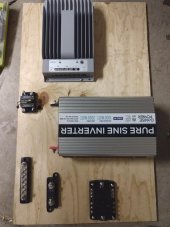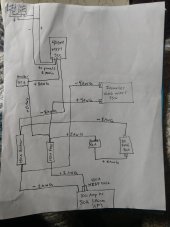Gabrielle
New Member
- Joined
- Apr 11, 2022
- Messages
- 76
I completed a setup and posted to this forum, where I received advice to rewire. So, working on the new set-up, trying to get it done today because I need to move into my RV asap! I'm still having trouble with the wiring.. I already posted this in the thread I started before, not trying to be spammy but posting a fresh thread thinking that might get more visibility?
I attached pictures of the new set up, one my hand drawn interpretation of a schematic...
I have 8 gauge running to the panels and 2 gauge wire running from the battery to the busbar and 150 amp mega fuse.
I'm thinking I should do 2 gauge from the inverter to the busbar and fuse, 8 gauge for all the rest of the connections. My logic is coming from what I understand of Wills book, videos, reading on forums, but it's possible that I'm way off here.
Thoughts??
Thanks in advance for sharing your knowledge, I only want to (re)do this once so trying to get it right!
I attached pictures of the new set up, one my hand drawn interpretation of a schematic...
I have 8 gauge running to the panels and 2 gauge wire running from the battery to the busbar and 150 amp mega fuse.
I'm thinking I should do 2 gauge from the inverter to the busbar and fuse, 8 gauge for all the rest of the connections. My logic is coming from what I understand of Wills book, videos, reading on forums, but it's possible that I'm way off here.
Thoughts??
Thanks in advance for sharing your knowledge, I only want to (re)do this once so trying to get it right!





